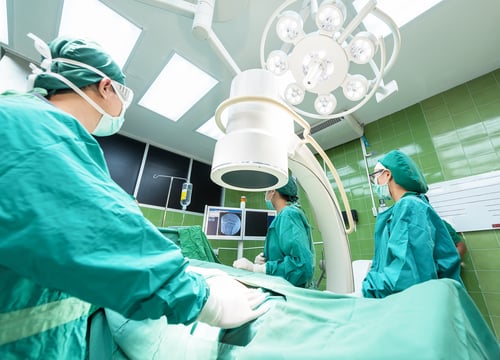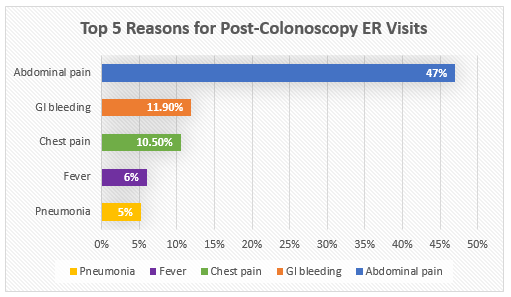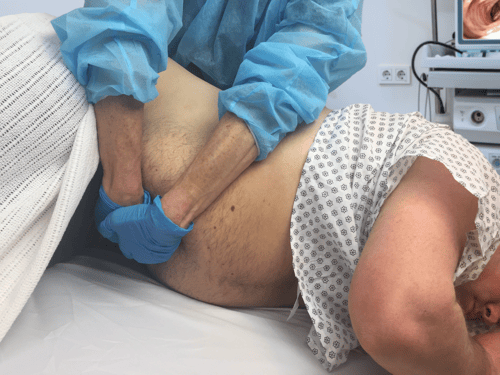Post-Colonoscopy ER Visits 4X More Likely GI Docs Think
by Larissa Biggers, on July 20, 2018
Part of what makes colonoscopy the gold standard for colon cancer screening is its safety profile. The risk of serious complications is low (perforations and post-procedure bleeding occur in only 0.05% and 0.3% of colonoscopies, respectively). Yet according to a study out of Yale, a far larger percentage of patients return to the emergency room (ER) within seven days of colonoscopy, with far-reaching impacts on cost and patient outcomes.

Nearly 1 in 50 Patients; GIs in the Dark
The study reviewed data from 325,000 healthy patients undergoing colonoscopy and found that nearly 5,200 (1.6%) visited a hospital or emergency department within seven days following their procedure. And this finding is conservative; patients with diverticulitis, inflammatory bowel disease, and serious chronic illnesses (i.e., those who are more likely to have complications) were not included in this study. Even more surprising: gastroenterologists were unaware of the patient’s readmission in 75% of the cases.
What Is Driving ER Visits?
By far, the most frequent complaint among patients returning to the ER after colonoscopy was abdominal pain. In fact, it was the cause of almost 50% of these visits. This is a significant figure compared to the second most cited cause, gastrointestinal bleeding, which led to just 12% of ER visits.

Perforation Risk is Low, Yet Ruling It Out Is Expensive
Abdominal pain is one of the primary symptoms of a bowel perforation. Although the rate of perforation from colonoscopy is low, when a patient is admitted to the ER with abdominal pain following the procedure, a full workup is required to rule out this serious complication. The exam, labs, and CT scan involved generate substantial costs. In 2010, the average price tag of such a visit was $6,355.71 per patient, based on Medicare expenditures. The actual charge and financial impact on patients is certainly several times this amount.
Gas and Bloating Cause Post-Procedure Pain, but Not ER Visits
The most widely acknowledged cause of post-colonoscopy abdominal pain is gas and bloating. During colonoscopy, the physician fills the bowel with gas so the lining can be more easily examined. The air can cause the patient to experience bloating and discomfort following the exam until the gas is expelled from the body, which can take up to 24 hours. In the Yale study, however, patients returning to the ER due to abdominal pain did so, on average, 4.4 days after their procedure. This means that in most cases, gas and bloating were not the source of the pain that prompted a visit to the ER.
Post-Procedure Pain: The Impact of a Difficult Colonoscopy
Another possible source of pain is actual trauma. Looping, a common challenge in colonoscopy, occurs when the colon stretches and distends as the physician attempts to advance the scope. Looping occurs in varying degrees in up to 90% of colonoscopies, but tends to be especially problematic for 10 to 15% of patients undergoing the procedure. Stretching of the colon and the mesentery due to looping can cause injury, leaving patients’ abdomens tender and sore for several days following their procedure.
In addition, common practices to mitigate looping are the application of manual abdominal pressure and patient repositioning during the procedure. For “difficult patients,” these maneuvers are often used extensively. Although pressure and repositioning remain the status quo, a recent study examining causes of post-colonoscopy pain in 300 patients found that two of the strongest predictors of post-procedure pain were 1) if manual abdominal compression was used and 2) if the patient was repositioned. In the study, patients who received manual abdominal pressure were more than 2X as likely to report moderate-to-severe pain, and those who were repositioned reported moderate-to-severe pain 8X more often than patients who weren’t.
 Application of pressure during colonoscopy
Application of pressure during colonoscopy
Reducing Post-Colonoscopy ER Visits: Options to Consider
Happily, most complications related to colonoscopy are minor, even though the cost of follow-up care is not. Undoubtedly, healthcare facilities, providers, and patients would like to avoid post-colonoscopy ER visits. But what can be done to lower the numbers?
To increase patient comfort, physicians should ensure that patients are adequately sedated and should make every attempt to decrease insufflation. In addition, reducing the application manual pressure and patient repositioning can benefit not only patients but also staff who are obligated to carry out these maneuvers. Devices that mitigate looping can go a long way toward reducing pain—and visits to the ER.


